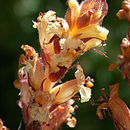en
names in breadcrumbs


Orobanche hederae, the ivy broomrape, is, like other members of the genus Orobanche, a parasitic plant without chlorophyll, and thus totally dependent on its host, which is ivy. It grows to 60 cm (2 ft), with stems in shades of brown and purple, sometimes yellow. The flowers are 10–22 mm (0.4–0.9 in) long, cream in colour with reddish-purple veins.[1]
Orobanche is derived from Greek, and means 'bitter vetch strangler'. This name originates from the species Orobanche rapum-genistae, which parasitizes legumes. The name hederae means 'of ivy', in reference to its host plant, Hedera.[2]
Common names in English include ivy broomrape and chokeweed.[3] It is also called erva-toira da hera in Portuguese and orobanche du lierre in French.[4]
Its yellowish to purplish stems are usually strongly swollen at the base and 15–60 cm (5.9–23.6 in) by 0.3–0.8 cm (0.12–0.31 in). They are covered in short soft glandular hairs. Leaves are acute and oblong to lance-shaped. It's calyx (sepals) are 10–15 mm (0.39–0.59 in) with free segments that are entire or unequally bifid. Its dull-cream to reddish purple corolla (petals) is 10–22 mm (0.39–0.87 in). They are almost hairless and upright spreading to more or less patent. Filaments (stalks of the stamen) are inserted 3–4 mm (0.12–0.16 in) above the base of the corolla. They are usually hairless but rarely somewhat hairy below. Fruit are 10–12 mm (0.39–0.47 in) capsules.[3]
In Mediterranean climates it flowers from late April to mid July.[3]
Its native distribution matches that of its host, ivy, so it is mainly found in central and Northern Europe.
In the US, the only place it has been observed is in a patch of ivy at the University of California, Berkeley. It is speculated that a botany student purposely planted it there since ivy is very invasive in California.[5]
O. hederae is usually included in the "Orobanche" section of genus Orobanche. Phylogenetic studies suggest the amethyst broomrape (O. amethystea) is its closest relative. O. amethystea primarily parasitizes field eryngo (Eryngium campestre) which is in the order Apiales.[6][7]
The Greek physician Dioscorides wrote that the plant, called Οροβαχνη, can be eaten raw or cooked like asparagus and also stated that cooking the plant with pulses makes the pulses cook faster. While Dioscorides doesn't include medicinal information in his description, Russian and Northern folklore both describe the plant as highly medicinal.[3]
Orobanche hederae, the ivy broomrape, is, like other members of the genus Orobanche, a parasitic plant without chlorophyll, and thus totally dependent on its host, which is ivy. It grows to 60 cm (2 ft), with stems in shades of brown and purple, sometimes yellow. The flowers are 10–22 mm (0.4–0.9 in) long, cream in colour with reddish-purple veins.